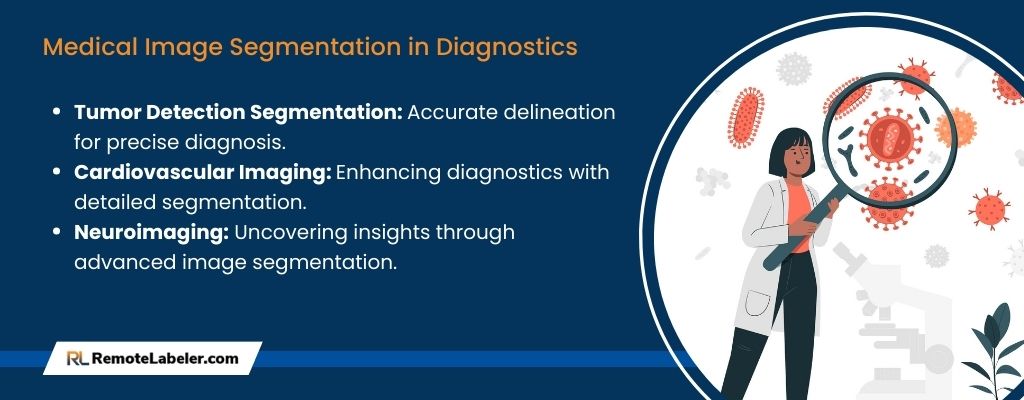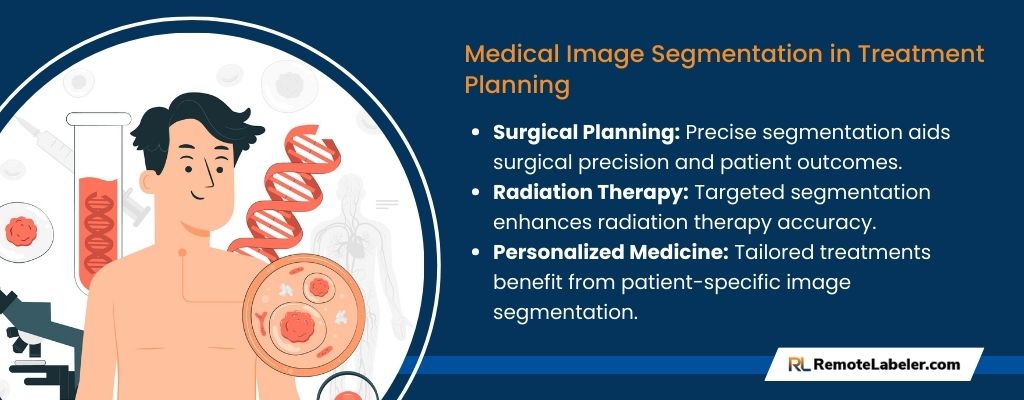In the intricate domain of medical diagnostics, the precision and clarity of images play a pivotal role. As the healthcare sector increasingly leans towards video annotation outsourcing to refine their datasets, medical image segmentation stands out as a technique of paramount importance. This method offers a deeper dive into medical images, allowing professionals to discern finer details and make informed decisions. In this article, we’ll delve into the intricacies of medical image segmentation, its applications, and its transformative role in diagnostics and treatment planning.
What is Medical Image Segmentation?
Medical image segmentation is the process of dividing a medical image into multiple segments, making it easier to visualize, interpret, and analyze specific anatomical structures. By isolating specific regions of interest in an image, professionals can gain a clearer understanding of potential abnormalities or conditions.
Types of medical imaging that commonly use segmentation include:
- MRI (Magnetic Resonance Imaging): Offers detailed views of soft tissues, making it invaluable for brain, spinal cord, and joint analyses.
- CT (Computed Tomography) Scans: Provides cross-sectional views of the body, often used for detecting tumors or assessing bone health.
- X-rays: Primarily used for viewing bones, but segmentation can help in identifying fractures or infections.
- Ultrasound: Commonly used during pregnancies or for viewing internal organs, with segmentation enhancing clarity.
Importance of Medical Image Segmentation
Medical image segmentation is not just a technical process; it’s a transformative tool that enhances the quality of healthcare delivery. By providing a detailed view of internal structures, it aids in accurate diagnoses and paves the way for personalized treatment plans.
Enhanced Visualization
Segmentation breaks down complex images into simpler, segmented parts, offering a clearer visualization of specific areas or structures within the body.
Precision in Diagnosis
By isolating regions of interest, medical professionals can pinpoint abnormalities with greater accuracy, ensuring timely and appropriate interventions.
Personalized Treatment Planning
With a detailed understanding of a patient’s condition, doctors can tailor treatment plans to individual needs, optimizing outcomes.
Medical Image Segmentation in Diagnostics

Medical image segmentation plays a pivotal role in diagnostics, offering clarity and precision that traditional imaging might miss.
Tumor Detection
Segmentation is invaluable in oncology. By segmenting medical images, radiologists can identify, measure, and monitor tumors over time. This not only aids in early detection but also in assessing the effectiveness of treatments, as shrinking or growing tumors can be accurately measured.
Cardiovascular Imaging
In cardiology, the clarity offered by segmentation is crucial. It aids in diagnosing conditions like blocked arteries, heart defects, or damaged heart muscles. By segmenting images of the heart and surrounding vessels, doctors can get a detailed view of blood flow, tissue health, and overall cardiac function.
Neuroimaging
For neurological conditions, segmentation offers insights into the brain’s structure and function. Whether it’s identifying areas affected by stroke, assessing damage from traumatic injuries, or monitoring degenerative conditions like Alzheimer’s, segmentation provides a detailed view that aids in both diagnosis and treatment planning.
By harnessing the power of medical image segmentation, the healthcare industry can ensure that patients receive accurate diagnoses and effective treatment plans, showcasing the transformative potential of medical image annotation and labeling in modern medicine.
Medical Image Segmentation in Treatment Planning
Medical image segmentation not only aids in accurate diagnosis but also plays a pivotal role in crafting effective and personalized treatment plans. By offering a granular view of internal structures, it provides medical professionals with the insights needed to make informed treatment decisions.

Surgical Planning
Segmentation is invaluable for surgeons preparing for operations. By breaking down complex images into segmented parts, surgeons can visualize the exact location, size, and relationship of tumors, blood vessels, and other structures. This clarity ensures that surgeons can make precise incisions, minimize damage to healthy tissues, and optimize surgical outcomes.
Radiation Therapy
In oncology, radiation therapy is a common treatment for cancer. Medical image segmentation aids in planning radiation treatment by clearly demarcating the tumor’s boundaries. This ensures that the radiation is accurately targeted, maximizing its effect on the tumor while minimizing damage to surrounding healthy tissues.
Personalized Medicine
The future of medicine is personalized, tailored to individual patient needs. Medical image segmentation contributes to this by providing detailed insights into a patient’s specific condition. Whether it’s understanding the progression of a disease, gauging the body’s response to treatments, or predicting potential health risks, segmentation offers the data required to craft customized treatment plans.
Challenges and Solutions in Medical Image Segmentation
Like any advanced technique, medical image segmentation comes with its set of challenges. However, with the right strategies and tools, these challenges can be effectively addressed.
Data Quality
Challenge: High-quality segmentation relies on high-quality images. However, not all medical images are of optimal quality, leading to potential inaccuracies in segmentation.
Solution: Advanced image enhancement techniques can improve image quality. Additionally, medical data annotation services like Remote Labeler can employ experts who are trained to work with varying image qualities, ensuring accurate segmentation.
Scalability
Challenge: As medical databases grow, segmenting each image individually can become a daunting task.
Solution: Automated segmentation tools, powered by AI and trained using keypoint annotation, can handle large datasets efficiently. Outsourcing to services like Remote Labeler can also ensure that large volumes of images are segmented accurately and in a timely manner.

Remote Labeler’s Expertise in Medical Image Segmentation
At Remote Labeler, we pride ourselves on our deep expertise in medical image segmentation. Our team, equipped with advanced tools and a keen understanding of the medical annotation process, has contributed to numerous projects, ensuring that medical professionals receive the most accurate data for their diagnostics and treatment planning. One notable project involved aiding a renowned oncology center in segmenting thousands of images to plan radiation therapies. Our precise segmentation ensured that patients received optimal radiation doses, minimizing side effects and maximizing treatment efficacy.
Conclusion
Medical image segmentation stands at the intersection of technology and healthcare, offering a lens into the body’s intricacies. Its role in diagnostics and treatment planning is undeniable, ensuring that patients receive the best care possible. As the medical world continues to evolve, the importance of techniques like medical image segmentation, and experts like Remote Labeler, will only grow.
Eager to tap into the potential of detailed medical image segmentation for your healthcare facility? Get in touch with us to get professional medical imaging annotation services.
- Emerging Trends and Future Outlook: The Data Labeling Industry in 2024-2030 - December 8, 2023
- Landmark Annotation: Key Points - November 6, 2023
- All You Should Know About Bounding Box Annotation - November 5, 2023